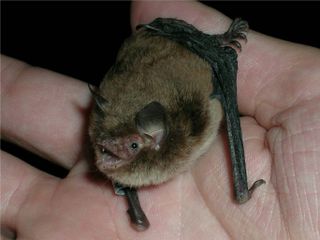Bats Have Surprisingly Complex Family Life

Group living has many benefits, but it also comes at a cost. A study of insect-eating bats in England finds that females and males often live at different altitudes, but can have surprisingly diverse mating behaviors.
Researchers observed the Daubenton's bat (Myotis daubentonii) along a 25-mile (40-kilometer) stretch of the River Wharfe in the Yorkshire Dales National Park. At lower altitudes the researchers found mostly mama bats and their babies, while males dominated at loftier altitudes. But at intermediate heights, males and females were found cohabiting. These living arrangements reflect tradeoffs bats make for access to food, warmth and other resources, scientists reported Thursday (Jan. 24) in the journal PLOS ONE.
"Most of the bats are segregated — males generally live apart from females," said ecologist and study leaderJohn Altringham of the University of Leeds. "The unusual thing in our study is we get males and females living together, too."
The bats probably segregate because there's not enough food to go around at higher altitudes. Mama bats need lots of nourishment when pregnant or nursing, so they can't afford to compete with the males. Alternatively, the male bats may opt to live alone to avoid the rampant parasites found in the close quarters of baby bat nurseries. [Flying Mammals: Gallery of Spooky Bats]
But the middle territory may be a happy medium where males and females can more easily satisfy feeding and mating needs.
While most of the bats live apart during the year, in late summer they congregate in droves near caves in a mating frenzy known as "swarming." Altringham likened it to a nightclub: "It's males just hanging around night after night trying to pick up girls." Only a lucky few will become fathers, however, because the females only produce one baby at a time. The males that live together with females at the middle altitudes may have the best shot, according to Altringham, because they can mate with females even before they reach the caves.
The bats, named for 18th-century French naturalist Louis-Jean-Marie Daubenton, are found widely across the United Kingdom. They feed on insects near bodies of water and hibernate for about six months of the year. Adults weigh about as much as a pencil — approximately 6 to 12 grams (0.2 to 0.4 ounces).
Sign up for the Live Science daily newsletter now
Get the world’s most fascinating discoveries delivered straight to your inbox.
Despite their size, "these tiny little animals have a social life that's much more complex than that of a bigger animal," Altringham said.
Follow LiveScience on Twitter @livescience. We're also on Facebook & Google+.

Most Popular


